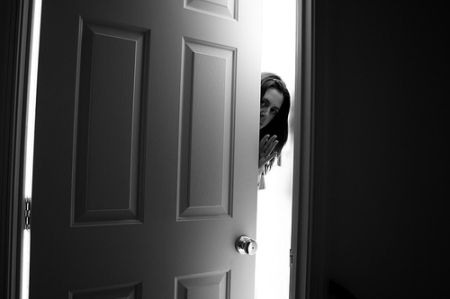“Every good writer has been told - Show, don’t tell. And every bad writer needs to be told again.” – a guy named Eddie.
There are a million people looking for writing advice and another million ready to provide it. However, just because someone offers something doesn’t mean that the something is worth taking. Just ask the man in the trench coat. If the most common piece of writer’s advice is Show, don’t tell, then why do those three words need to be repeated so often? Either those offering or those receiving, or both, don’t really understand what it means.
Warning: if any of the following writing samples seem like something you may have written, then either this is purely a coincidence or you purely need to pay attention.
1. “I think you have the wrong house,” she said angrily.
2. “I think you have the wrong house,” she said shyly.
3. “I think you have the wrong house,” she said teasingly.
4. “I think you have the wrong house,” she said happily.
You might have a good grasp of what’s happening here, but you might not be impressed. Either way, these are all good/bad examples of telling instead of showing. It is the same line of dialogue each time, which is okay. What’s not okay is the context – which doesn’t really exist. The only difference is the one adverb at the end of each attribution.
What’s an attribution? The “he said” or “she said” that usually accompanies dialogue and identifies the speaker. The problem here is that each attribution is the same except for that one adverb. There’s nothing wrong with adverbs except in sentences like the four above because there is nothing interesting about just one adverb. That’s why good writers try to avoid overusing them. Notice I said “try.”
In each of those sentences, we are “told” how the woman feels: happy, angry, shy, teasy. Horny. Whatever. Just follow along. There are two problems. First, when reading the dialogue – “I think you have the wrong house” – we have no idea what’s happening until after the spoken words are over. It would be more interesting if we had some context before the words came out. You know - context clues. Here is the same line of dialogue, four times, but with a little something added.
1. With a tight jaw and sharp eyes, she growled, “I think you have the wrong house.”
2. She showed one eye where the door was open only a few inches, then she whispered, “I think you have the wrong house.”
3. She raised one eyebrow, hooked her thumbs in the waistband of her cut-off jeans, and shifted her barefoot stance from one hip to the other. “I think you have the wrong house.”
4. She removed his company cap, put it backwards on her own head, and shrugged. “I think you have the wrong house.”
Readers aren’t stupid. Most readers aren’t stupid. You’re not stupid. Right? You don’t want to complete a puzzle with sequentially numbered pieces. You don’t want a maze that has a map. And you don’t want to be told what is happening. You want to see it for yourself. You want to feel it, experience it, uncover it, and be there as it is revealed in front of your eyes.
You don’t want to be told that a woman was scared to death when a carjacker knocked her into the backseat and drove her car away. You want to see her white-knuckle grip on the door handle as she weighs opening the door and rolling out as he slows to 40 mph around a turn.
Let’s look back at the woman who answered the door. Not the angry one. The tease. If I want to tell you more about her, I might mention her having “ruby red lips” or “lips painted crimson.” Sound good? No – it doesn’t. It sucks. What good is it to tell you a color when I can show you a color? Names of colors are meaningless, except on crayons. Then they're fun. What matters are things that actually are those colors.
Her lips held a shine as if she had just kissed blood.
Now we’re getting somewhere. I want to know more about this woman. Instead of telling you she has red lips, I’m showing you not just a thing that is red but a thing that holds a lot of mystery and feeling. Blood. Yeah, she bad. Blood is bad. There’s never a good reason to see blood, unless you’re on a table making a donation to the Red Cross. This chick is bad. How bad? We don’t really know yet, but I would love to find out. If we’re lucky, maybe she will “show” us just how bad she is. Like that time I was in the parking lot of a bar in Philly and I – well – nevermind.
Focus. Focus. Well, let's think about it. If your slutty neighbor is fooling around with the cable guy, would you prefer she tell you or show you?
That's what I thought.



You get the point across with clear examples and photos. Helpful!
ReplyDeletei completely agree. and thanks very much for reading. the photos are a bonus here, so it's good that i can get away with it.
ReplyDelete